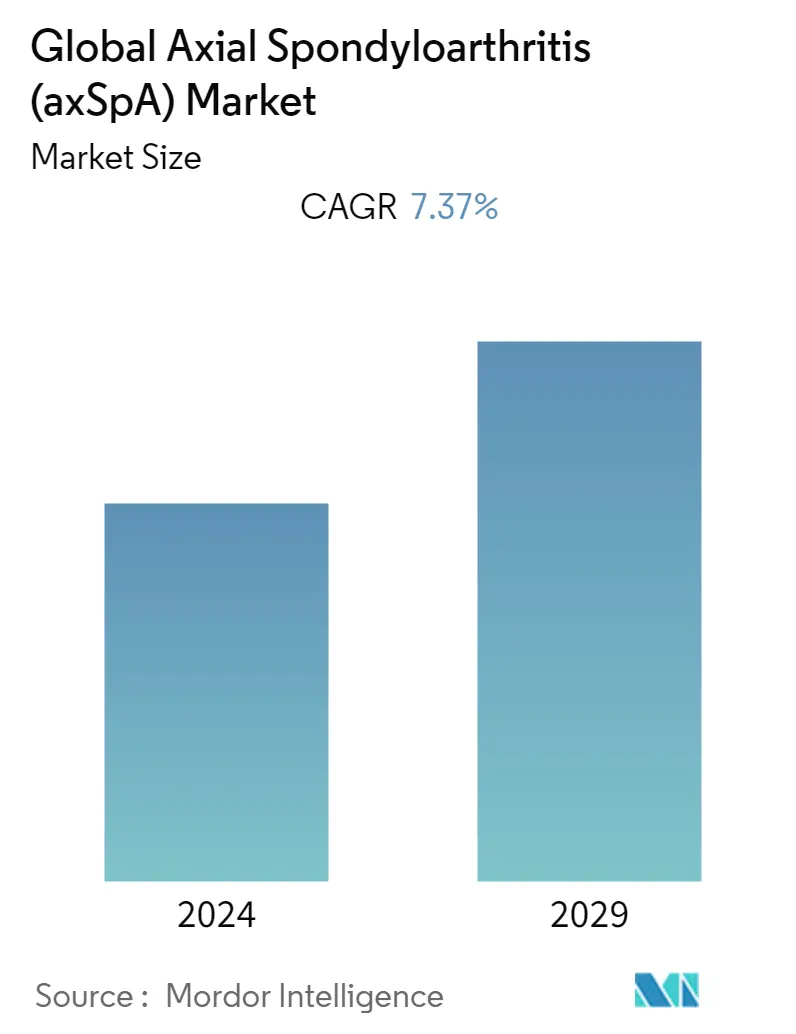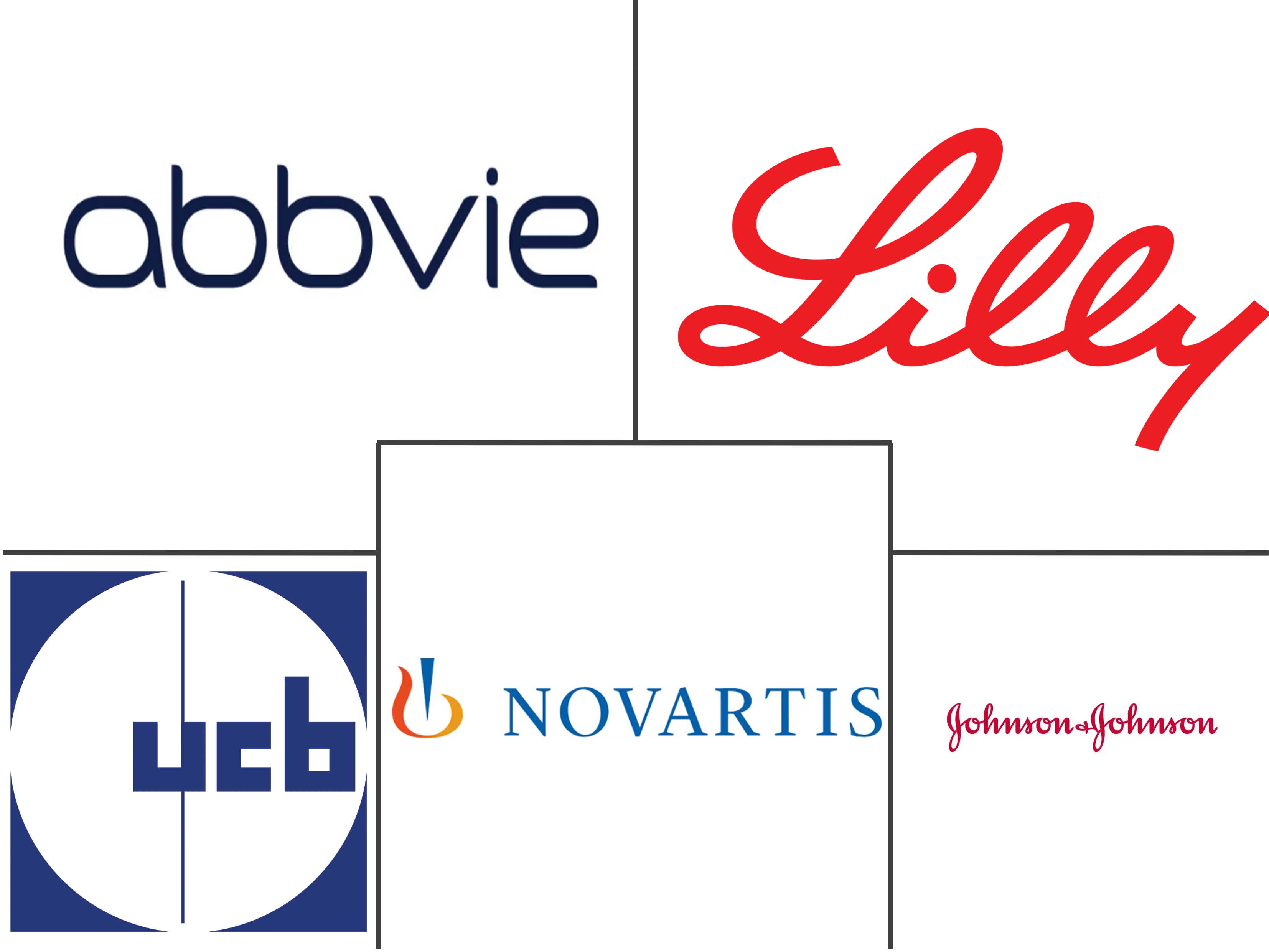Market Size of Global Axial Spondyloarthritis (axSpA) Industry

| Study Period | 2019 - 2029 |
| Base Year For Estimation | 2023 |
| Forecast Data Period | 2024 - 2029 |
| CAGR | 7.37 % |
| Fastest Growing Market | Asia-Pacific |
| Largest Market | North America |
Major Players
*Disclaimer: Major Players sorted in no particular order |
Axial Spondyloarthritis (axSpA) Market Analysis
The Axial Spondyloarthritis market is projected to register a CAGR of 7.37% during the forecast period (2022-2027).
With the increasing COVID-19 cases worldwide, healthcare services diverted all resources toward patients suffering from COVID-19 disease. Although COVID-19 severely affects the respiratory system, it has created multiple uncertainties regarding rheumatic diseases or their treatment about the susceptibility to or severity of the viral disease. The COVID-19 pandemic has been especially challenging for patients with inflammatory diseases, including spondyloarthritis (SpA). Although numerous studies have addressed how a COVID-19 infection affects patients with rheumatic diseases, the conclusions from these reports have not been consistent. A study published in The Journal of Rheumatology in 2022 captured responses from 4723 subjects with SpA and 450 household contacts of these subjects showed that the COVID-19 pandemic created multiple uncertainties regarding rheumatic diseases or their treatment with regard to the susceptibility or severity of the viral disease.
There has been increased research and development going on for rheumatic diseases during the pandemic. For instance, in February 2021, EULAR, the European Alliance of Associations for Rheumatology, launched COVAX. This is a doctor-reported registry to collect information about COVID vaccination in people with both inflammatory and non-inflammatory rheumatic and musculoskeletal diseases (RMDs).
Certain factors that are driving the market growth include improvements in awareness which result in the increased patient pool that proves to be positive upfront for the Axial spondyloarthritis market and helps patients to try new interventions. There are several governmental and non-governmental organizations coming up to raise awareness among the general population about the condition. There are several initiatives taking place to advocate for people about the diagnosis and treatment of the same. Some of the initiatives include Rheumatoid Arthritis Awareness Day, supported by groups such as Arthritis National Research Foundation, which is held in February each year. In addition to this, Rheumatic Disease Awareness Month (RDAM) is held in September in the United States. As a result of increased awareness, people are aware of the diagnosis, and hence, the overall market will boost in the forecasted period.
Additionally, as part of the Bone and Joint Week celebration in October 2021, Novartis announced the renewal of its partnership with the Axial Spondyloarthritis Association of the Philippines (ASAPh) and Philippine Rheumatology Association (PRA) to raise awareness of Axial Spondyloarthritis (axSpA) early diagnosis and treatment.
The advent of biologic drugs has transformed the management of patients with axial spondyloarthritis. An increase in biologics is another factor that can drive the market. As per the American College of Rheumatology, Non-steroidal anti-inflammatory drugs (commonly called NSAIDs) offer symptom relief for most patients by reducing pain and swelling. Other medicines called biologics, including anti-TNF drugs (TNF blockers) and anti-IL-17 drugs (IL-17 blockers), are effective in patients who do not respond well enough to NSAIDs. The first lines of treatment are the NSAIDs, such as naproxen, ibuprofen, meloxicam, or indomethacin. Biologic medicines are manufactured within a living system, and target specific molecules believed to be involved in axial SpA. They are made up of genetically engineered proteins and are very large, complex molecules. The National Institute for Health and Care Excellence (NICE) has produced written national guidelines about prescribing anti-TNF therapy and anti-IL-17A that must be followed.
In addition to this, until very recently, there were five licensed anti-TNF drugs (adalimumab, certolizumab, etanercept, golimumab, and infliximab) for the indication of ankylosing spondylitis and four (adalimumab, etanercept, certolizumab, and golimumab) for the indication of Non-Radiographic Axial Spondyloarthritis (in the United States, only certolizumab was approved for the indication of Non-Radiographic Axial Spondyloarthritis). The IL-17 blocker secukinumab has been approved by both the European Medicines Agency (EMA) and the United States Food and Drug Administration (FDA) for the indication of ankylosing spondylitis. Ixekizumab was initially (2019) approved by the FDA for ankylosing spondylitis, and in July 2020, the FDA expanded the approval of ixekizumab to include Non-Radiographic Axial Spondyloarthritis; almost simultaneously, the EMA also approved ixekizumab for the treatment of both ankylosing spondylitis and Non-Radiographic Axial Spondyloarthritis.
Thus, owing to the abovementioned factors, the market is expected to show growth over the forecast period. However, severe adverse effects of certain therapeutic drugs significantly hinder the market's growth.
Axial Spondyloarthritis (axSpA) Industry Segmentation
As per the scope of this report, Axial spondyloarthritis (axSpA) is a chronic inflammatory rheumatic disease that primarily affects the sacroiliac joints and spine and commonly presents in patients aged < 40 years with inflammatory back pain (IBP) as a presenting symptom. The axial Spondyloarthritis (axSpA) market is segmented by Types (Ankylosing spondylitis (AS) and Non-radiographic axial spondyloarthritis (nr-axSpA)), By Drug Class (Non-steroidal anti-inflammatory drugs (NSAID), Glucocorticoids, Anti-rheumatic drugs, and Others), and Geography (North America, Europe, Asia-Pacific, Middle-East and Africa, and South America). The report offers the value (in USD million) for the above segments.
| By Types | |
| Ankylosing spondylitis (AS) | |
| Non-radiographic axial spondyloarthritis (nr-axSpA) |
| By Drug class | |
| Non-steroidal anti-inflammatory drugs (NSAID) | |
| Glucocorticoids | |
| Anti-rheumatic drugs | |
| Others |
| Geography | ||||||||
| ||||||||
| ||||||||
| ||||||||
| ||||||||
|
Global Axial Spondyloarthritis (axSpA) Market Size Summary
The axial spondyloarthritis (axSpA) market is poised for significant growth, driven by increased awareness and advancements in treatment options. The market is characterized by a rising patient pool, supported by initiatives from governmental and non-governmental organizations aimed at raising awareness about the condition. The introduction of biologic drugs has revolutionized the management of axSpA, with biologics such as anti-TNF and anti-IL-17 drugs offering effective alternatives for patients unresponsive to traditional non-steroidal anti-inflammatory drugs (NSAIDs). The market's expansion is further bolstered by new product launches and partnerships, such as those between Novartis and the Axial Spondyloarthritis Association of the Philippines, which focus on early diagnosis and treatment. Despite the challenges posed by severe adverse effects of certain therapeutic drugs, the market is expected to experience robust growth over the forecast period.
North America is anticipated to hold a substantial share of the global axSpA market, attributed to heightened awareness, increased prevalence, and improved diagnostic capabilities in the region. The United States, in particular, faces a significant patient population, with high healthcare expenditure and awareness contributing to market growth. The market landscape is competitive and fragmented, with major players like Johnson & Johnson, UCB, Amgen, and Novartis Pharmaceuticals Corporation leading the charge. Collaborative efforts, such as the partnership between Ampersand Health and UCB, aim to enhance patient management and quality of life. The market's trajectory is supported by ongoing research and development, as evidenced by studies demonstrating the efficacy of treatments like Ixekizumab in managing axSpA symptoms and progression.
Global Axial Spondyloarthritis (axSpA) Market Size - Table of Contents
-
1. MARKET DYNAMICS
-
1.1 Market Overview
-
1.2 Market Drivers
-
1.2.1 Improvements in awareness and increasing patient pool
-
1.2.2 Advancements of biologica and New therapeutic options in the pipeline
-
-
1.3 Market Restraints
-
1.3.1 Delayed Diagnosis and High cost involved in treatment
-
-
1.4 Porter's Five Forces Analysis
-
1.4.1 Threat of New Entrants
-
1.4.2 Bargaining Power of Buyers/Consumers
-
1.4.3 Bargaining Power of Suppliers
-
1.4.4 Threat of Substitute Products
-
1.4.5 Intensity of Competitive Rivalry
-
-
-
2. MARKET SEGMENTATION (Market Size by Value - USD million)
-
2.1 By Types
-
2.1.1 Ankylosing spondylitis (AS)
-
2.1.2 Non-radiographic axial spondyloarthritis (nr-axSpA)
-
-
2.2 By Drug class
-
2.2.1 Non-steroidal anti-inflammatory drugs (NSAID)
-
2.2.2 Glucocorticoids
-
2.2.3 Anti-rheumatic drugs
-
2.2.4 Others
-
-
2.3 Geography
-
2.3.1 North America
-
2.3.1.1 United States
-
2.3.1.2 Canada
-
2.3.1.3 Mexico
-
-
2.3.2 Europe
-
2.3.2.1 Germany
-
2.3.2.2 United Kingdom
-
2.3.2.3 France
-
2.3.2.4 Italy
-
2.3.2.5 Spain
-
2.3.2.6 Rest of Europe
-
-
2.3.3 Asia-Pacific
-
2.3.3.1 China
-
2.3.3.2 Japan
-
2.3.3.3 India
-
2.3.3.4 Australia
-
2.3.3.5 South Korea
-
2.3.3.6 Rest of Asia-Pacific
-
-
2.3.4 Middle-East and Africa
-
2.3.4.1 GCC
-
2.3.4.2 South Africa
-
2.3.4.3 Rest of Middle-East and Africa
-
-
2.3.5 South America
-
2.3.5.1 Brazil
-
2.3.5.2 Argentina
-
2.3.5.3 Rest of South America
-
-
-
Global Axial Spondyloarthritis (axSpA) Market Size FAQs
What is the current Global Axial Spondyloarthritis (axSpA) Market size?
The Global Axial Spondyloarthritis (axSpA) Market is projected to register a CAGR of 7.37% during the forecast period (2024-2029)
Who are the key players in Global Axial Spondyloarthritis (axSpA) Market?
Janssen Biotech, AbbVie, UCB, Amgen and Novartis Pharmaceuticals Corporation are the major companies operating in the Global Axial Spondyloarthritis (axSpA) Market.

